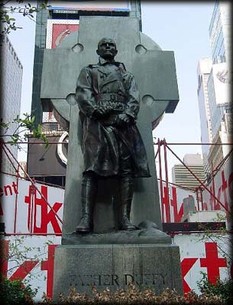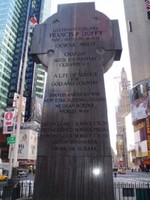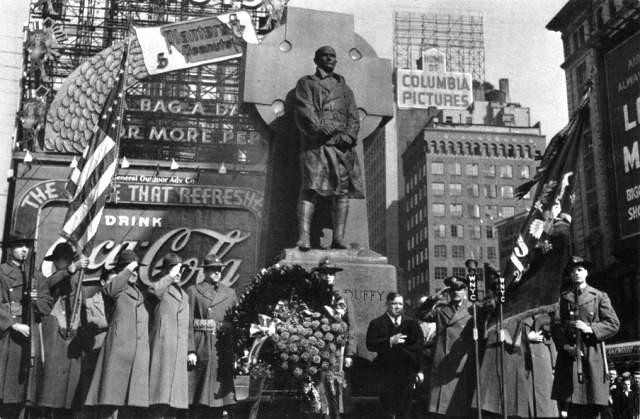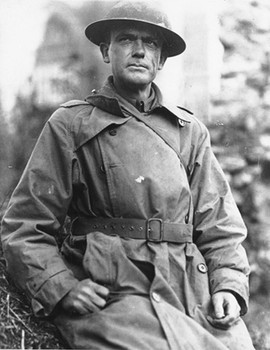Father Francis P. Duffy Monument
Introduction
Text-to-speech Audio
Images
The front of the monument

The back of the monument

A picture of the dedication ceremony in 1937

Father Duffy in military uniform in undated photograph

Backstory and Context
Text-to-speech Audio
Francis Patrick Duffy was born in the town of Cobourg in the Canadian province of Ontario on May 2, 1871. His parents were Irish immigrants and he was one of their eleven children. After graduating from college in Toronto, Duffy left Canada for New York City in 1893 after accepting a position teaching French at the Jesuit-run College of St. Francis Xavier (now Xavier High School) in Manhattan. Soon after, he commenced studies to become a Catholic priest. In 1896, Duffy was ordained in the New York Archdiocese. He then completed graduate studies at the Catholic University of America in Washington, D.C. before accepting a faculty position teaching philosophy at St. Joseph’s Seminary in Yonkers in 1898.
That same year, Duffy began what would become a decorated military career. During the Spanish-American War, he served as a first lieutenant and chaplain of the “Fighting Sixty-Ninth,” a mostly Irish-American unit. After the war, Duffy returned to St. Joseph’s Seminary and helped establish The New York Review, a Catholic theological journal. The publication’s participation in the Modernist movement drew the suspicion and ire of Church leadership. After only a few months in existence, The New York Review ceased publication. For Duffy’s involvement with the periodical, the New York Archdiocese reassigned him to Our Saviour Church, which operated out of a converted storefront in the Bronx. Over the course of a four years, Duffy oversaw the construction of a new house of worship for the parish, along with a school and daycare facility. In 1916, he once again became chaplain of the “Fighting Sixty-Ninth.” During the national mobilization for the Great War, the regiment was reorganized as the 165th U.S. Infantry and became part of the Forty-Second “Rainbow” Division. After he and his unit were shipped off to Europe, Duffy experienced heavy fighting on the Western Front, particularly at St. Mihiel in September 1918 and the Meuse-Argonne the following month. Duffy survived the war and remained on active duty until 1920. For his service, Duffy received the Distinguished Service Cross, the Distinguished Service Medal, and the Conspicuous Service Cross, in addition to the Légion d’honneur and the Croix de Guerre.
In 1920, Duffy returned to New York City, where he became pastor of Holy Cross Church on West Forty-Second Street in Manhattan. He would ultimately serve in the position for over a decade. In June 1932, Duffy died of natural causes. His funeral was held at St. Patrick’s Cathedral and his remains were interred at St. Raymond’s Cemetery in the Bronx. An estimated 50,000 people turned out to line the route of the funeral cortege.
Soon after Duffy’s death, a movement began to honor the soldier-priest with a proper memorial. By 1933, the Father Duffy Memorial Committee was formed and began raising funds. With the help of the Works Progress Administration (WPA), the committee commissioned sculptor Charles Keck to design a monument. In 1935, Keck’s model received the approval of the Municipal Art Commission. Two years later, the monument—an over-life-sized bronze statue of Duffy in military uniform on a green granite pedestal backed by a more than seventeen-foot-tall Celtic cross—was dedicated in front of an estimated crowd of 30,000. Mayor Fiorello LaGuardia presided over the dedication ceremony. The triangular plaza on which the monument stands was renamed Father Duffy Square in 1939.
Sources
Chicoine, Christie L. "Father Duffy Recalled as Chaplain Who Exemplified Love of God, Country." Catholic New York. 11 July 2018. Web. 30 October 2020 <https://cny.org/stories/father-duffy-recalled-as-chaplain-who-exemplified-love-of-god-country,17601>.
"Father Duffy Square." New York City Department of Parks and Recreation. The City of New York. Web. 30 October 2020 <https://www.nycgovparks.org/parks/father-duffy-square/history>.
"Father Francis P. Duffy." New York City Department of Parks and Recreation. The City of New York. Web. 30 October 2020 <https://www.nycgovparks.org/parks/father-duffy-square/monuments/416>.
McNamara, Pat. "Father Francis P. Duffy and the Fighting 69th." Patheos. 8 November 2011. Web. 30 October 2020 <https://www.patheos.com/resources/additional-resources/2011/11/father-francis-p-duffy-and-the-fighting-69th-pat-mcnamara-11-08-2011.aspx?p=2>.
http://daytoninmanhattan.blogspot.com/2011/08/father-francis-p-duffy-statue-times.html
https://the-american-catholic.com/chaplain-francis-duffy-world-war-i/
